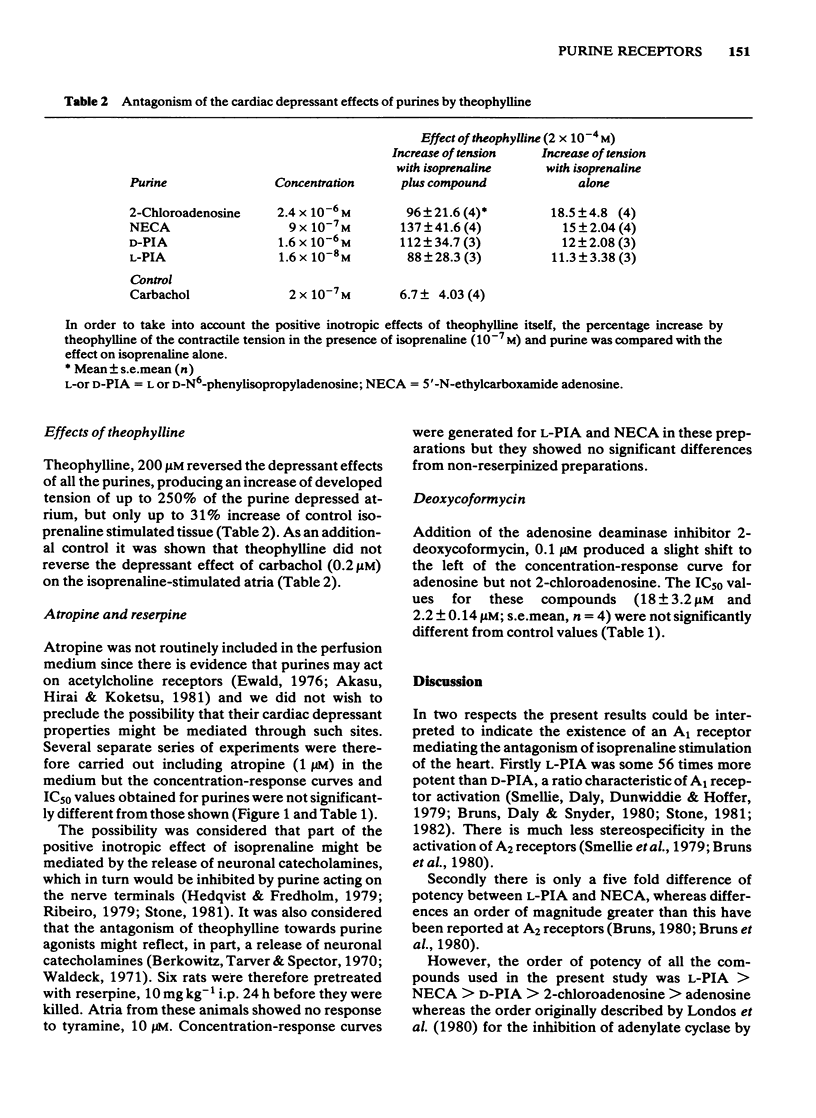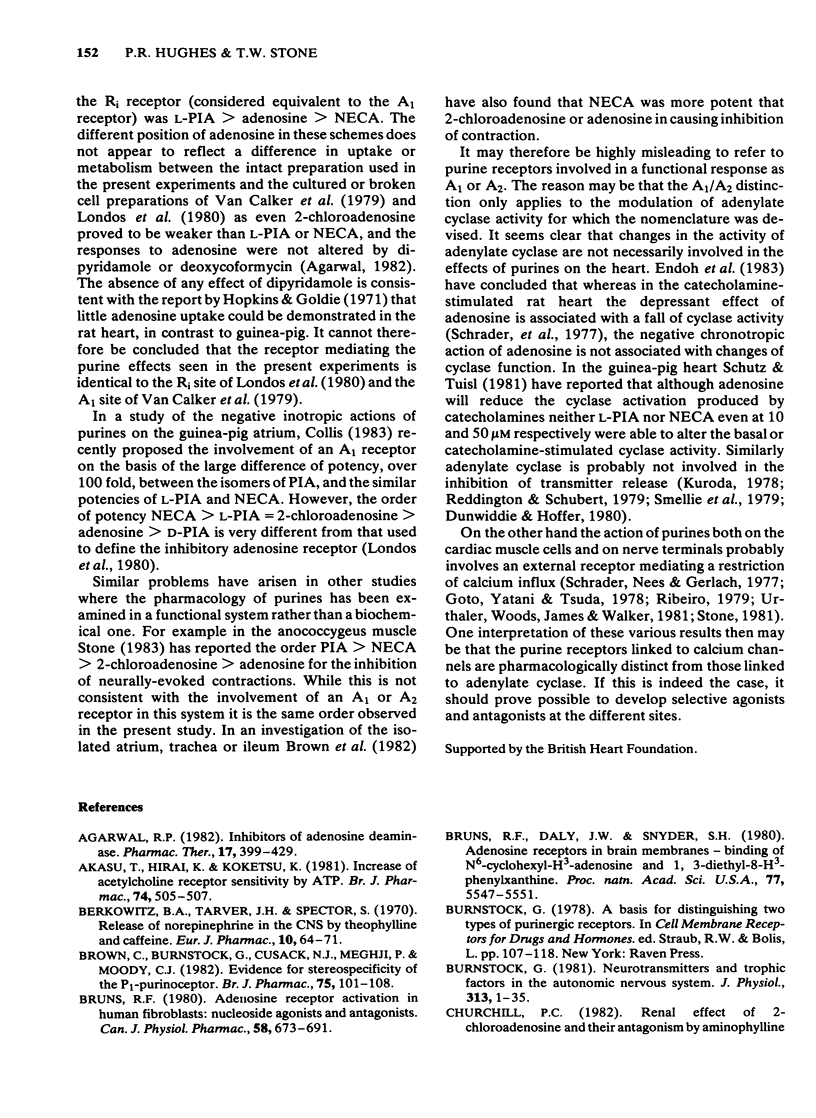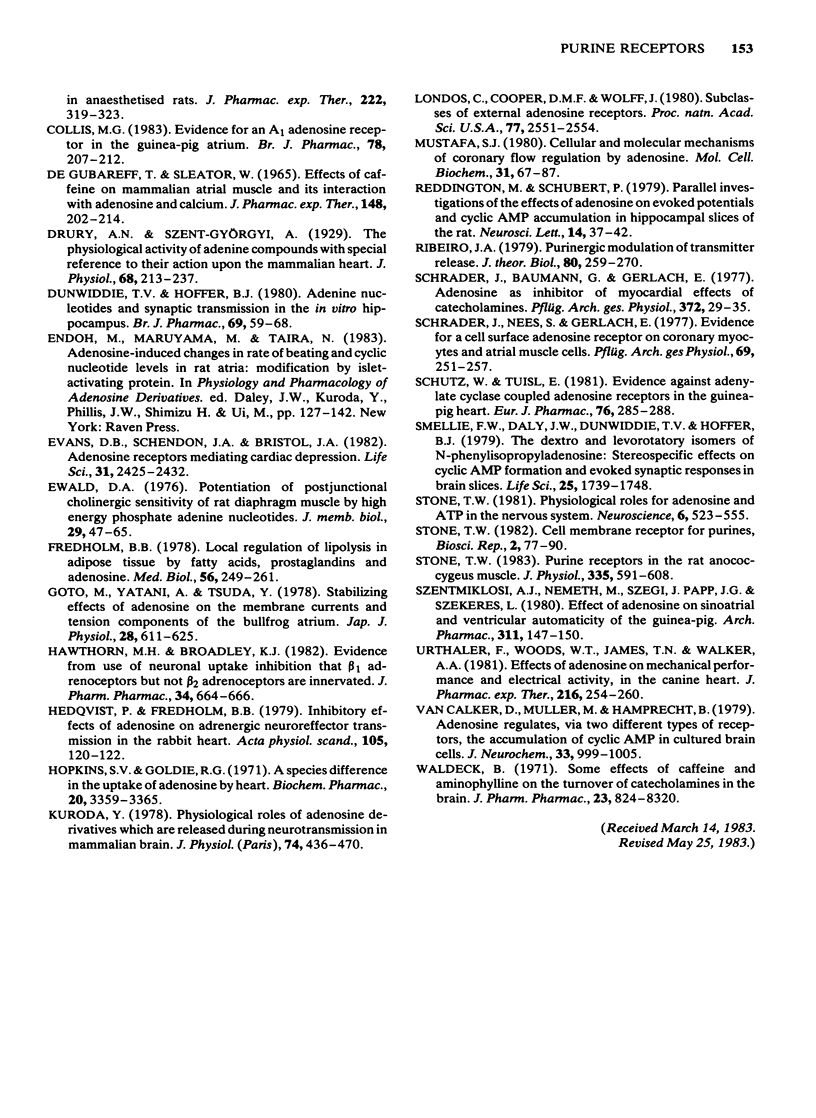Abstract
The effects of a series of adenosine derivatives were examined on the catecholamine-stimulated electrically-driven rat left atrium in vitro. All the purines tested reduced the positive inotropic action of isoprenaline, 0.1 microM, with the potency order: L-N6-phenlylisopropyladenosine (L-PIA) greater than 5'-N-ethylcarboxamide adenosine (NECA) greater than D-PIA greater than 2-chloroadenosine greater than adenosine. Dipyridamole did not change the IC50 of adenosine. The adenosine deaminase inhibitor, 2'deoxycoformycin, produced a small but nonsignificant shift to the left of the adenosine concentration-response curve. The cardiac depressant effects of these purines were reversed by theophylline and the IC50 values were unchanged in the presence of atropine or in atria taken from reserpine-treated rats. It is concluded that the purine receptor mediating these effects should not be classified on the A1/A2 system. The relationship between functionally characterized purine receptors and those originally defined as modulating adenylate cyclase is discussed.
Full text
PDF




Selected References
These references are in PubMed. This may not be the complete list of references from this article.
- Agarwal R. P. Inhibitors of adenosine deaminase. Pharmacol Ther. 1982;17(3):399–429. doi: 10.1016/0163-7258(82)90023-7. [DOI] [PubMed] [Google Scholar]
- Akasu T., Hirai K., Koketsu K. Increase of acetylcholine-receptor sensitivity by adenosine triphosphate: a novel action of ATP on ACh-sensitivity. Br J Pharmacol. 1981 Oct;74(2):505–507. doi: 10.1111/j.1476-5381.1981.tb09997.x. [DOI] [PMC free article] [PubMed] [Google Scholar]
- Berkowitz B. A., Tarver J. H., Spector S. Release of norepinephrine in the central nervous system by theophylline and caffeine. Eur J Pharmacol. 1970 Apr;10(1):64–71. doi: 10.1016/0014-2999(70)90158-5. [DOI] [PubMed] [Google Scholar]
- Brown C., Burnstock G., Cusack N. J., Meghji P., Moody C. J. Evidence for stereospecificity of the P1-purinoceptor. Br J Pharmacol. 1982 Jan;75(1):101–107. doi: 10.1111/j.1476-5381.1982.tb08762.x. [DOI] [PMC free article] [PubMed] [Google Scholar]
- Bruns R. F. Adenosine receptor activation in human fibroblasts: nucleoside agonists and antagonists. Can J Physiol Pharmacol. 1980 Jun;58(6):673–691. doi: 10.1139/y80-110. [DOI] [PubMed] [Google Scholar]
- Bruns R. F., Daly J. W., Snyder S. H. Adenosine receptors in brain membranes: binding of N6-cyclohexyl[3H]adenosine and 1,3-diethyl-8-[3H]phenylxanthine. Proc Natl Acad Sci U S A. 1980 Sep;77(9):5547–5551. doi: 10.1073/pnas.77.9.5547. [DOI] [PMC free article] [PubMed] [Google Scholar]
- Burnstock G. Review lecture. Neurotransmitters and trophic factors in the autonomic nervous system. J Physiol. 1981;313:1–35. doi: 10.1113/jphysiol.1981.sp013648. [DOI] [PMC free article] [PubMed] [Google Scholar]
- Churchill P. C. Renal effects of 2-chloroadenosine and their antagonism by aminophylline in anesthetized rats. J Pharmacol Exp Ther. 1982 Aug;222(2):319–323. [PubMed] [Google Scholar]
- Collis M. G. Evidence for an A1-adenosine receptor in the guinea-pig atrium. Br J Pharmacol. 1983 Jan;78(1):207–212. doi: 10.1111/j.1476-5381.1983.tb09381.x. [DOI] [PMC free article] [PubMed] [Google Scholar]
- DEGUBAREFF T., SLEATOR W., Jr EFFECTS OF CAFFEINE ON MAMMALIAN ATRIAL MUSCLE, AND ITS INTERACTION WITH ADENOSINE AND CALCIUM. J Pharmacol Exp Ther. 1965 May;148:202–214. [PubMed] [Google Scholar]
- Drury A. N., Szent-Györgyi A. The physiological activity of adenine compounds with especial reference to their action upon the mammalian heart. J Physiol. 1929 Nov 25;68(3):213–237. doi: 10.1113/jphysiol.1929.sp002608. [DOI] [PMC free article] [PubMed] [Google Scholar]
- Dunwiddie T. V., Hoffer B. J. Adenine nucleotides and synaptic transmission in the in vitro rat hippocampus. Br J Pharmacol. 1980 May;69(1):59–68. doi: 10.1111/j.1476-5381.1980.tb10883.x. [DOI] [PMC free article] [PubMed] [Google Scholar]
- Evans D. B., Schenden J. A., Bristol J. A. Adenosine receptors mediating cardiac depression. Life Sci. 1982 Nov 29;31(22):2425–2432. doi: 10.1016/0024-3205(82)90746-9. [DOI] [PubMed] [Google Scholar]
- Ewald D. A. Potentiation of postjunctional cholinergic sensitivity of rat diaphragm muscle by high-energy-phosphate adenine nucleotides. J Membr Biol. 1976 Oct 20;29(1-2):47–65. doi: 10.1007/BF01868951. [DOI] [PubMed] [Google Scholar]
- Fredholm B. B. Local regulation of lipolysis in adipose tissue by fatty acids, prostaglandins and adenosine. Med Biol. 1978 Oct;56(5):249–261. [PubMed] [Google Scholar]
- Goto M., Yatani A., Tsuda Y. Stabilizing effects of adenosine on the membrane currents and tension components of the bullfrog atrium. Jpn J Physiol. 1978;28(5):611–625. doi: 10.2170/jjphysiol.28.611. [DOI] [PubMed] [Google Scholar]
- Hawthorn M. H., Broadley K. J. Evidence from use of neuronal uptake inhibition that beta 1-adrenoceptors, but not beta 2-adrenoceptors, are innervated. J Pharm Pharmacol. 1982 Oct;34(10):664–666. doi: 10.1111/j.2042-7158.1982.tb04697.x. [DOI] [PubMed] [Google Scholar]
- Hedqvist P., Fredholm B. B. Inhibitory effect of adenosine on adrenergic neuroeffector transmission in the rabbit heart. Acta Physiol Scand. 1979 Jan;105(1):120–122. doi: 10.1111/j.1748-1716.1979.tb06321.x. [DOI] [PubMed] [Google Scholar]
- Hopkins S. V., Goldie R. G. A species difference in the uptake of adenosine by heart. Biochem Pharmacol. 1971 Dec;20(12):3359–3365. doi: 10.1016/0006-2952(71)90440-0. [DOI] [PubMed] [Google Scholar]
- Kuroda Y. Physiological roles of adenosine derivatives which are released during neurotransmission in mammalian brain. J Physiol (Paris) 1978;74(5):463–470. [PubMed] [Google Scholar]
- Londos C., Cooper D. M., Wolff J. Subclasses of external adenosine receptors. Proc Natl Acad Sci U S A. 1980 May;77(5):2551–2554. doi: 10.1073/pnas.77.5.2551. [DOI] [PMC free article] [PubMed] [Google Scholar]
- Mustafa S. J. Cellular and molecular mechanism(s) of coronary flow regulation by adenosine. Mol Cell Biochem. 1980 Jun 18;31(2):67–87. doi: 10.1007/BF00240813. [DOI] [PubMed] [Google Scholar]
- Reddington M., Schubert P. Parallel investigations of the effects of adenosine on evoked potentials and cyclic AMP accumulation in hippocampus slices of the rat. Neurosci Lett. 1979 Sep;14(1):37–42. doi: 10.1016/0304-3940(79)95340-0. [DOI] [PubMed] [Google Scholar]
- Ribeiro J. A. Purinergic modulation of transmitter release. J Theor Biol. 1979 Sep 21;80(2):259–270. doi: 10.1016/0022-5193(79)90210-8. [DOI] [PubMed] [Google Scholar]
- Schrader J., Baumann G., Gerlach E. Adenosine as inhibitor of myocardial effects of catecholamines. Pflugers Arch. 1977 Nov 25;372(1):29–35. doi: 10.1007/BF00582203. [DOI] [PubMed] [Google Scholar]
- Schrader J., Nees S., Gerlach E. Evidence for a cell surface adenosine receptor on coronary myocytes and atrial muscle cells. Studies with an adenosine derivative of high molecular weight. Pflugers Arch. 1977 Jul 19;369(3):251–257. doi: 10.1007/BF00582192. [DOI] [PubMed] [Google Scholar]
- Schütz W., Tuisl E. Evidence against adenylate cyclase-coupled adenosine receptors in the guinea pig heart. Eur J Pharmacol. 1981 Dec 3;76(2-3):285–288. doi: 10.1016/0014-2999(81)90516-1. [DOI] [PubMed] [Google Scholar]
- Smellie F. W., Daly J. W., Dunwiddie T. V., Hoffer B. J. The dextro and levorotatory isomers of N-phenylisopropyladenosine: stereospecific effects on cyclic AMP-formation and evoked synaptic responses in brain slices. Life Sci. 1979 Nov 12;25(20):1739–1748. doi: 10.1016/0024-3205(79)90477-6. [DOI] [PubMed] [Google Scholar]
- Stone T. W. Cell-membrane receptors for purines. Review. Biosci Rep. 1982 Feb;2(2):77–90. doi: 10.1007/BF01116173. [DOI] [PubMed] [Google Scholar]
- Stone T. W. Physiological roles for adenosine and adenosine 5'-triphosphate in the nervous system. Neuroscience. 1981;6(4):523–555. doi: 10.1016/0306-4522(81)90145-7. [DOI] [PubMed] [Google Scholar]
- Stone T. W. Purine receptors in the rat anococcygeus muscle. J Physiol. 1983 Feb;335:591–608. doi: 10.1113/jphysiol.1983.sp014553. [DOI] [PMC free article] [PubMed] [Google Scholar]
- Waldeck B. Some effects of caffeine and aminophylline on the turnover of catecholamines in the brain. J Pharm Pharmacol. 1971 Nov;23(11):824–830. doi: 10.1111/j.2042-7158.1971.tb10198.x. [DOI] [PubMed] [Google Scholar]
- van Calker D., Müller M., Hamprecht B. Adenosine regulates via two different types of receptors, the accumulation of cyclic AMP in cultured brain cells. J Neurochem. 1979 Nov;33(5):999–1005. doi: 10.1111/j.1471-4159.1979.tb05236.x. [DOI] [PubMed] [Google Scholar]


